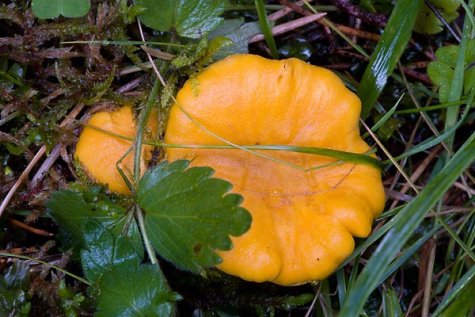Summer mushroom time
Photo Arne Ader
Translation Liis
Chanterelle
Chanterelle; Girolle Harilik kukeseen Cantharellus cibarius
The summer mushroom period starts with the chanterelles in June. This year the forests have been well watered, there has been no real drought; a little bit of warmth and blueberry picking and mushrooming will be real options. Picking chanterelles in this era of mild winters has dragged on into January: chanterelles aren’t damaged by a few degrees of frost.
Chanterelles often grow in coniferous or mixed forests. The mushroom mycorrhiza forms with many tree species: spruce, pine, even with oak. As the chanterelles grow preferably in damp moss and grass finding the first one takes some work, finding the next ones is already easier.
As very young the mushroom cap is dome-shaped, edges curled inwards. On growing a little, it becomes funnel-shaped, with a wavy or lobed margin. The mushroom stem tapers towards the ground. The underside of the cap has ridges resembling gills. The whole is crowned with the beautiful chanterelle yellow colour.
On tasting raw chanterelles a slightly bitter aftertaste is left in the mouth. Precisely this taste and the particular smell, reminding of fruit, makes chanterelles extremely ”maggot resistant”. It probably contains some substance unpleasant for vermin. No risk to people has been documented from it. Towards autumn especially large fruiting bodies can be found. Chanterelles are truly long-lived, the age of such a specimen may exceed some months (these seniors have not managed to retain the beautiful exterior – in places a little mouldy, but still undamaged by pests).
Much is written about preparing and preserving the delicious chanterelles. Moreover every experienced mushroom picker has his or her interesting additions.
Similar species:
Pale chanterelle Kahvatu kukeseen Cantharellus pallens
A paler chanterelle, as the name says. In Estonia only found in Saaremaa until now. This excellent eating mushroom can be found in late summer in wooded meadows or mixed forests. In places there may be large numbers of it. Why speak of the mushrooms of Saaremaa? Well, one day we might be able to pick the C. pallens on the mainland too?
False chanterelle Kuld-kukeseen Hygrophoropsis aurantiaca
The false chanterelle period begins in late summer, in August; they can become very numerous in late autumn, growing in forests, clear-cut areas or decaying tree stumps.
The false chanterelle has a bright orange, round cap, which is somewhat smaller than that of the proper chanterelle, and grows on a narrower strem.
On picked mushrooms we see proper gills on the underside of the cap, not small ridges as on the real chanterelle. The false chanterelle is believed to be conditionally edible, but earlier it has been held to be poisonous.
Wood hedgehog; Sweet tooth Timpnarmik Hydnum repandum
We can find the hedgehog mushroom too already in July and in quite variable forests still in November.
The hedgehog mushroom reminds of the chanterelle but on the whitish or pale yellow underside we find the teeth (hymenophores) that are the origin of the name.
Young and small fruiting bodies can be used without parboiling, and are equal to the common chanterelle in taste. Somewhat larger hedgehog mushrooms however should rather be left in the forest, they are not good for eating.
Terracotta hedgehog Pruunjas narmik Hydnum rufescens
The terracotta hedgehog has a reddish-yellow to brown cap; stem and underside whitish. You can find them in the same habitats as the paler hedgehog mushroom, and in the same period.
As young the mushrooms can be used for eating, and they are delicious. But leave all large mushrooms in the forest!










